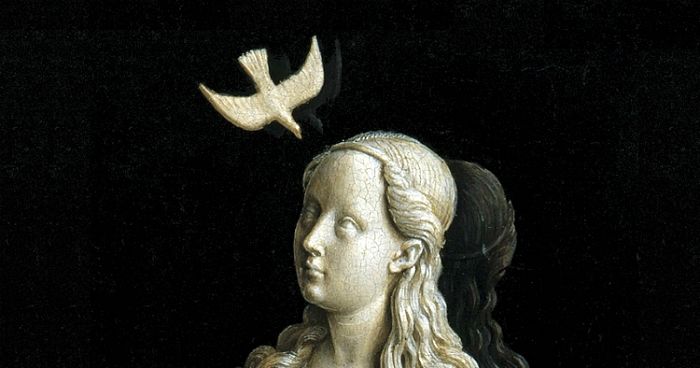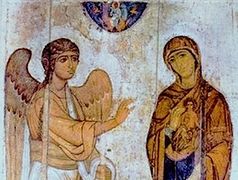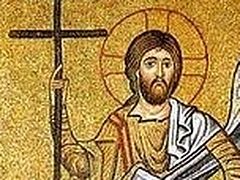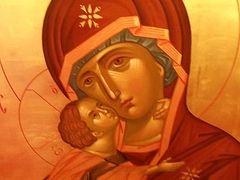Source: Theology That Sticks
March 24, 2016
Scholars believe they have unearthed the oldest icon of the Virgin Mary. Discovered in the ruins of a third-century house church in Syria, the image depicts a woman at a well.
Most of us don’t immediately associate Mary with a well, but the early church did. It’s the opening scene of the Annunciation, liturgically celebrated on March 25. Though the gospels are mute on the point, one ancient tradition mentions Mary at work and stopping for a drink.
“[T]aking a pitcher, she went out to fill it with water,” reports the second-century Protoevangelion of James. “And a voice sounded: Rejoice, favored one, the Lord is with you. Blessed are you among women” (11.1, Frederica Mathewes-Green’s translation).
“The virgin was fasting and standing in prayer near a fountain,” echoed Maximus the Confessor a few centuries later (Life of the Virgin 2.19).
What I find fascinating is this: In discussing this particular ancient image of Mary, Fordham professor Michael Peppard mentions it was found in a baptistry.
Layers of significance
The longer I live in the Orthodox liturgical tradition the more I notice the way one season informs the next. It’s like filo dough. The fasts and feasts are layered one atop another. Tasting one means tasting them all, and Mary in the baptistry offers a perfect example of the phenomenon.
It’s common to think of Christmas as the main Christian holiday, but Easter was tops for the earliest believers. As a result, fixing the date of Jesus’ crucifixion was key. Eastern Christians adopted April 6; Western Christians took March 25.
These dates are important, as William J. Tighe explains, because of a concept known as “integral age.” In Christ’s day, people commonly believed prophets died on the same date as their conception or birth. Christ’s conception immediately followed Mary’s response to Gabriel’s news.
The baptistry icon signals this connection. Says Peppard,
a field sketch of the [image] done “to show additional details” depicts two painted lines touching the woman’s back, along with a kind of starburst on the front of her torso, features described as “unexplained” in the archaeological report. But . . . the lines invite a rather evident meaning. They appear to represent a motion toward the woman’s body and a spark of activity within it, as if something invisible were approaching and entering her—an incarnation.
Here’s where we can spot the layers. When it comes to Christmas, many assume the church “christianized” an existing pagan holiday so new converts would commemorate Jesus instead of a Roman deity. But that’s not the case.
When Christians began celebrating the Nativity, the date was preset by the earlier agreement on the date of the Annunciation/crucifixion. Counting nine months for the duration of Mary’s pregnancy, believers landed on January 6 (Epiphany) in the East and December 25 (Christmas) in the West.
You can see how easily Augustine holds these concepts together:
For He is believed to have been conceived on the 25th of March, upon which day also He suffered; so the womb of the Virgin, in which He was conceived . . . corresponds to the new grave in which He was buried. . . . But He was born, according to tradition, upon December the 25th. (On The Trinity 4.5)
This is, in other words, a wholly in-house question. And the pieces are interconnected. Celebrating Christmas means celebrating the Annunciation, which means celebrating Easter.
But another important aspect of the linkage is found in our baptismal icon of Mary.
Preparing for baptism
Historically speaking, Lent is the baptismal season. In the weeks preceding Easter, catechumens prepared themselves for their final initiation into the sacramental life of the church.
Finding Mary depicted at a fountain on the walls of a baptistry makes perfect sense when we recognize the connection between the Annunciation and Easter. Not only does the Annunciation occur during this preparatory period, the abovementioned notion of integral age ties Christ’s conception with his crucifixion.
The liturgical layering effect shows up here as well. Throughout the paschal season Orthodox Christians sing the line from Galatians 3.27: “As many of you as have been baptized into Christ have put on Christ, Alleluia.”
Being baptized means dying and rising with Christ. But guess when we also sing this short hymn? During the Christmas service. It turns out the Christmas service (and Epiphany as well) are patterned on the Easter service, as Fr. Tom Hopko explains here. Layer upon layer upon layer.
To one degree or another, catechumens entering the baptismal pool would possess these thoughts as a unified whole, just like Augustine above. And an image like Mary at the fountain would help tie it all together.
Seeing the whole
If we’re attentive, we can notice these connections in the services today, as well. After all, says Fr. Patrick Henry Reardon in his outstanding new book, Reclaiming the Atonement,
these are liturgical mysteries. In the spring of each year, the Church devotes special times of prayer, reflection, and observance to [the] means of our redemption: the Word’s Incarnation on March 25, our Lord’s suffering and atoning death during Holy Week, and His Resurrection, celebrated through the fifty days . . . of the pascal season. (Volume One: The Incarnation)
A final point is worth mentioning, one made by Fr. John Behr in The Mystery of Christ. Not only are we looking backward when we commemorate feasts like the Annunciation, so were the apostles and early Christians who preserved the tradition of Mary at the well.
They experienced the same layering effect we do because they remembered and wrote from this side of the Resurrection too. They could only see the Annunciation and Nativity by looking through Easter.
Mary standing near the well is already Mary sitting by the manger, weeping at the cross, and rejoicing over an empty tomb.




